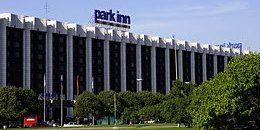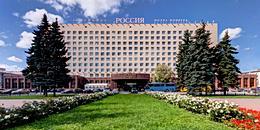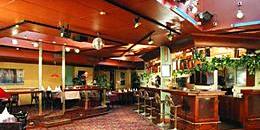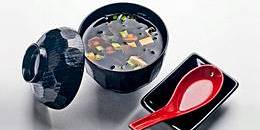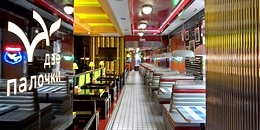Ploshchad Pobedy (Victory Square)
Ploshchad Pobedy, with its location at the southern tip of the city, is often referred to as a "gateway" into St. Petersburg. Here the highways leading from Kiev and Moscow to St. Petersburg converge (the former is also the main road from Pulkovo Airport to the city centre). Not so long ago, this location was known as Srednyaya Rogatka, which roughly translates as "Middle Checkpoint", as in the 18th century there were three guard-posts with barriers blocking the road into the city.

Until the mid-20th century, Ploshchad Pobedy was well beyond St. Petersburg's city limits. In fact, from 1714 it was the site of a travelling palace used by the Imperial family on their way south to Tsarskoye Selo. The original wooden palace was replaced during the reign of Empress Elizabeth with a modest stone building designed by the great rococo architect Francesco Bartolomeo Rastrelli. The palace was later used as a post house, then an inn, and finally in 1850 was converted into a factory making printing ink and paint.
During the Second World War, Ploshchad Pobedy was just behind the front line during the Siege of Leningrad, the site of artillery units and other defenses. The second life of the area began in 1945 when a wooden Triumphal Arch of Victory was built to greet soldiers returning from abroad.

In 1971, Rastrelli's much-altered palace was completely demolished and construction began on the square's grand monument to the Heroic Defenders of Leningrad. The monument faces Pulkovo Heights, the series of hills to the south of the city where the German forces were halted in 1941 and remained until the Siege of Leningrad was broken in January 1944. The center of the monument is a granite obelisk forty-eight meters in height, framed by a "broken circle" of granite, with bronze sculptures depicting the different types of citizen who contributed to the defense of the city. On the walls are engraved the names of the 650 Heroes of the Soviet Union who received that title due to their bravery during the Battle of Leningrad. Under the monument is a museum hall that displays 900 bronze plates chronicling the events of the besieged city. Here you can also see the map of defensive strategies for Leningrad as well as stone sarcophagi which store personal relics such as a loaf of bread from the blockade, an oil lamp, shell casings, and a Komsomol card pierced by bullets. The grand opening of the monument took place on May 9th, 1975, the 30th anniversary of the Day of Victory in the Great Patriotic War.
Maintaining the circular symmetry of the space, two identical 22-story tower-blocks were erected 1973-1975 across the northern corners of Ploshchad Pobedy. In a rather more elegant modern style, flanking the space to the east and west, the almost identical Pulkovskaya Hotel (now the Park Inn Pulkovskaya) and the Elektrostandart Institute were joint Soviet-Finnish projects completed in 1981 and 1983 respectively. Today, Ploshchad Pobedy provides a grand welcome to visitors to St. Petersburg, while reminding them of the defining tragedy that shaped the city's recent history.
| Metro stations: | Moskovskaya |
|---|---|
| Directions: | Exit Moskovskaya Metro Station following signs for the airport buses. Turn left out of the underpass and walk along Moskovsky Prospekt around 300 m. |
| What's here? | Monument to the Heroic Defenders of Leningrad |
| What's nearby? | Moskovsky Prospekt Park Gorodov-Geroev (Hero Cities Park) |

